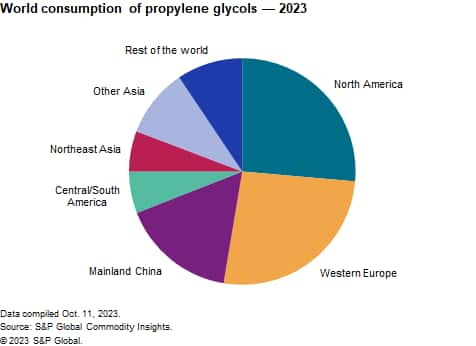Published December 2023
Propylene glycol, dipropylene glycol and higher glycols are produced commercially from propylene oxide. Monopropylene glycol is used in a wide variety of applications, including unsaturated polyester resins, cosmetics and personal care products, functional fluids and antifreezes, liquid detergents and dog food. Dipropylene glycol is used in unsaturated polyester resins, plasticizers and personal care applications. Tripropylene glycol is used in polyurethanes and acrylates.
Global consumption of propylene glycols will continue to grow at an average of 2.5%-3.0% per year during 2023–28. Higher-than-average growth rates will be observed in regions such as mainland China, South Asia, Southeast Asia and Oceania, and Central and Eastern Europe, where strong demand for unsaturated polyester resins, cosmetics and personal care products is expected to be seen in the forecast period.
The following pie chart shows world consumption of propylene glycols:

For more detailed information, see the table of contents, shown below.
S&P Global’s Chemical Economics Handbook –Propylene Glycols is the comprehensive and trusted guide for anyone seeking information on this industry. This latest report details global and regional information, including

Key benefits
S&P Global’s Chemical Economics Handbook –Propylene Glycols has been compiled using primary interviews with key suppliers and organizations, and leading representatives from the industry in combination with S&P Global’s unparalleled access to upstream and downstream market intelligence and expert insights into industry dynamics, trade and economics.
This report can help you
- Identify trends and driving forces influencing chemical markets
- Forecast and plan for future demand
- Understand the impact of competing materials
- Identify and evaluate potential customers and competitors
- Evaluate producers
- Track changing prices and trade movements
- Analyze the impact of feedstocks, regulations, and other factors on chemical profitability


















